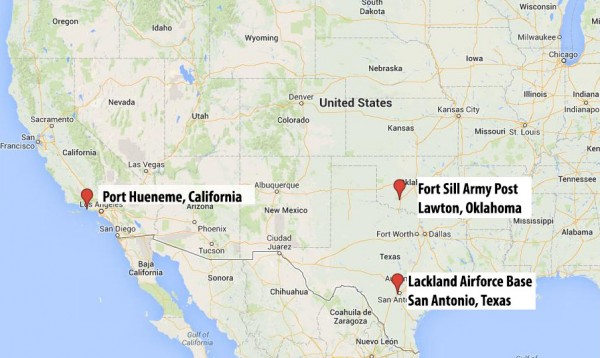WASHINGTON – A surge of unaccompanied children arriving from Central America at the U.S.-Mexico border will not be given legal status, U.S. Homeland Security Secretary Jeh Johnson said this week.
“I wish to make clear that those apprehended at our border are priorities for removal. They are priorities for enforcement of our immigration laws regardless of age,” Johnson said.
Johnson held a press conference Thursday in which he laid out an 11 point plan to accommodate the children that includes a request for more temporary shelters and preliminary health screenings.
As many as 60,000 children could arrive at the U.S.-Mexico border this year. This number is up from roughly 24,000 in 2013, according to the Department of Health and Human Services, which will care for them.

This map shows the location of three temporary shelters being used by the U.S. Department of Health and Human Services to house unaccompanied children arriving from Central America at the U.S.-Mexico border. Officials from the Department of Homeland Security say these shelters house about 3,000 children. (SHFWire graphic by Anna GilesHHS)
“The unaccompanied children arriving from Central America are vulnerable and have significant needs,” Mark Greenberg, HHS acting assistant secretary for the Administration for Children and Families, said. “They are young and separated from their families and have barely survived a hazardous journey. HHS has a responsibility to temporarily take care of these children.”
Most of the children are arriving from Mexico, Guatemala, El Salvador and Honduras and often travel to the U.S. to escape abuse, find family members or find work to support themselves, according to HHS.
Johnson did not answer questions during the press conference about what the shelters’ capacity is.
HHS funds a network of roughly 100 state licensed shelters operated by nonprofit organizations. When children arrive, they receive medical screenings, immunizations and a mental health exam, Greenberg said.
Kenneth Cole, HHS deputy director of the Office of Public Affairs of the Administration for Children and families wrote in an email that there are three temporary shelters: Lackland Air Force Base in San Antonio holds about 1,100 children; Port Hueneme, Calif., holds 600 children and Fort Sill in Lawton, Okla., holds 1,200 children.
Johnson said he has asked the U.S. Coast Guard to loan aircraft to help transport the children to the shelters.
Craig Fugate, administrator of the Federal Emergency Management Agency, said support for these children has come from outside of the government.
“A lot of the initial response to this has been through the faith-based community, and they are active not only at the point where we are bring basic care to these children but are also important in the resettlement opportunities of fostering children as they go through the program,” Fugate said.
Children are usually placed in long-term foster care or are returned to their families while they await a court hearing, Fugate said.
Johnson warned that the situation is dire.
“We provide a number of things for the children when we find them because the law requires it, and our values require it, but it is not safe and it is not a desirable situation, and I would encourage no parent to send their children through this process,” Johnson said.
_____
Editor’s note: This story was previously published on the Scripps Howard Fundation Wire.

